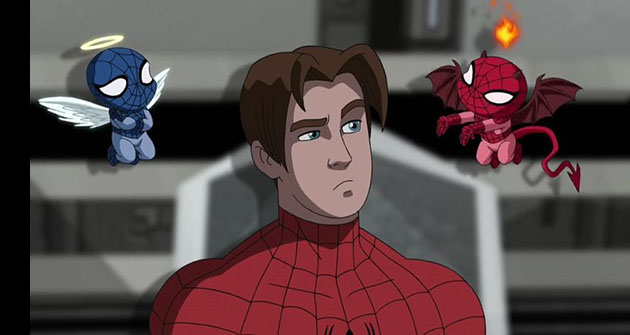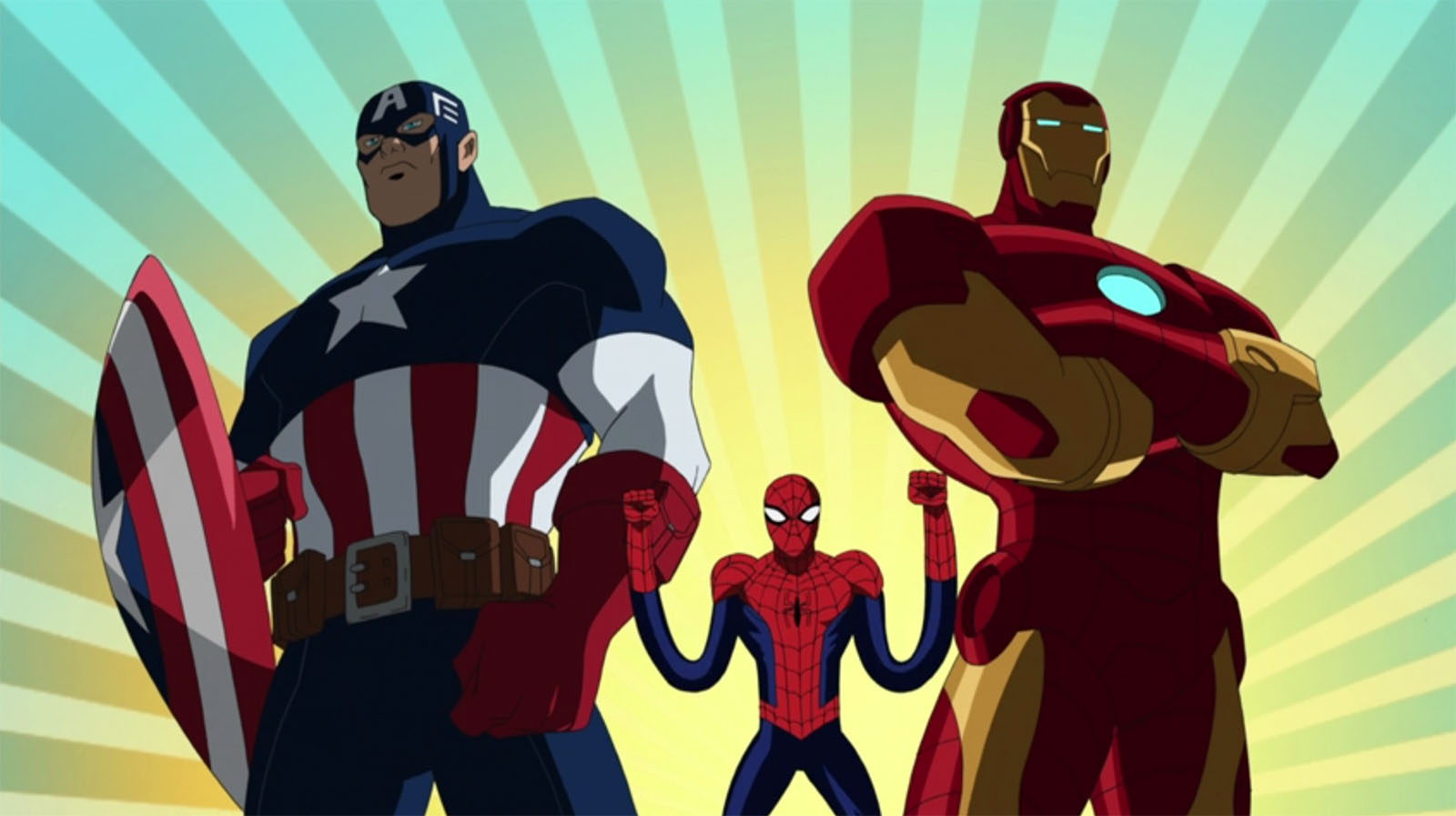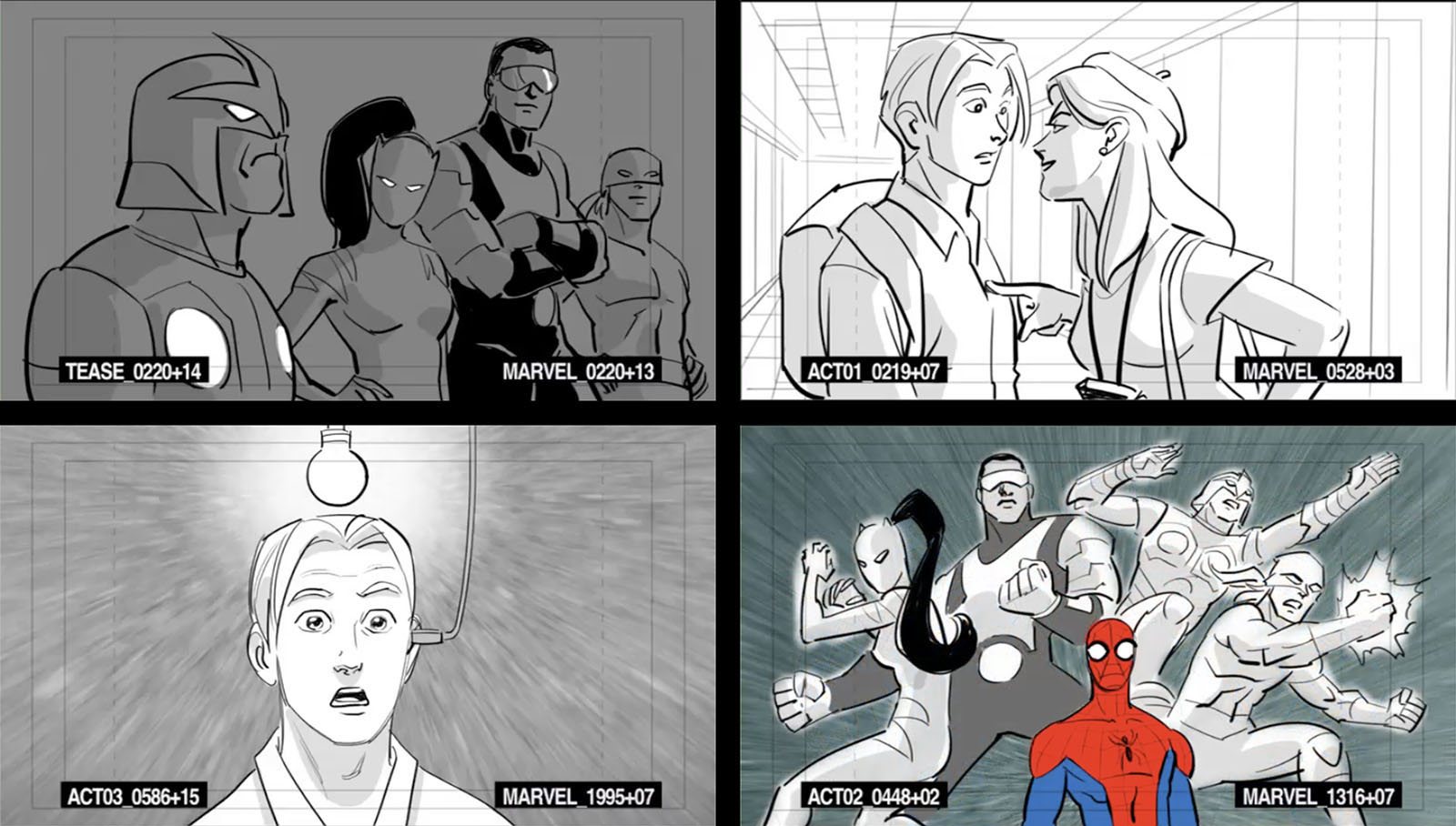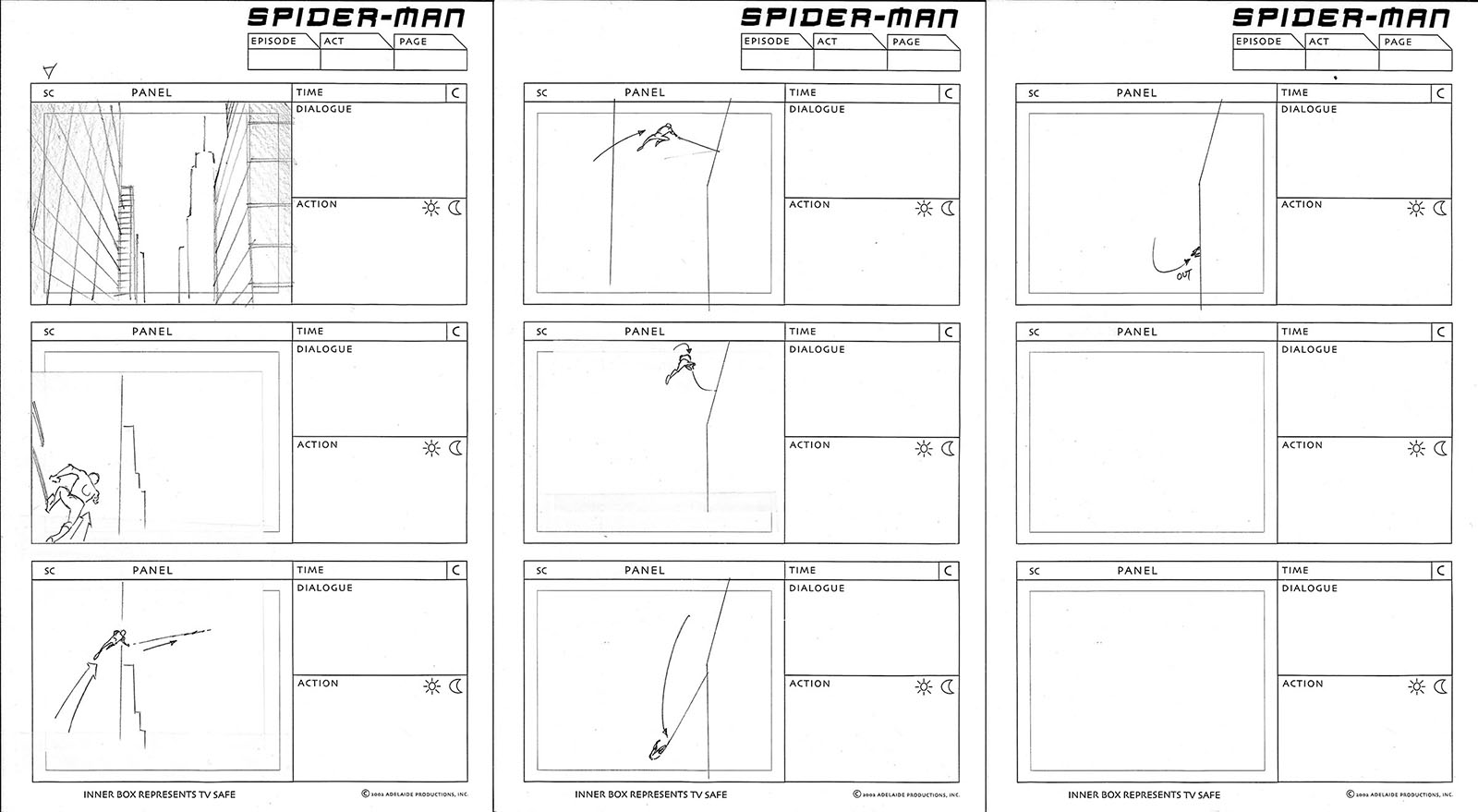Ultimate Spider-Man Season 1, 2011
My involvement in this series was deeper and more significant than on Spectacular Spider-Man; it pushed me through a technological turning point and into Marvel Animation Studio for almost ten years.
By this time, my tenure on The Brave and the Bold and Avengers: Earth’s Mightiest Heroes had ended, and I needed new freelance gigs to replace them. Ultimate Spider-Man came along at just the right time to become the first. The producer was Eric Radomski, who I worked for on both Xiaolin Showdown and Scooby Doo and Shaggy. The supervising director was Alex Soto, who I’d met over ten years earlier at Sony Animation.
This was the first Spider-Man cartoon made under the Disney umbrella, and the major difference from its predecessors was that Spidey was no longer a loner. He’d been “adopted” into SHIELD by Nick Fury and given partners to work with: Power Man, Iron Fist, Nova, and White Tiger. In other words, it would be a team show. That was the first thing that rankled longtime fans, because Spidey had never been a team player. He was far too angsty for that. Now things were different for one simple reason: more characters equalled more merch. That was the philosophy that drove all the Marvel shows for the next several years: Superhero Squad, Avengers Assemble, Hulk and the Agents of S.M.A.S.H., Guardians of the Galaxy, and Marvel Rising. Team shows were the directive.
The style of USM was close enough to both previous versions for me to jump right in, and the added layer of 4th-wall breaking and “Super Deformed” Spidey inserts were a fun new element to play with. But that’s where the easy part ended. Everything else about it was difficult and challenging in ways I wasn’t prepared for. I’ll start with the technological turning point.
After some fits and starts, the digital drawing era had arrived for real. We could no longer draw with pencils on paper, we now had to get expensive tablets (the industry standard is the Cintiq) and draw in a computer program. (I was already a Photoshop guy, so that was my preference.) That shift did not go well for me.
A pencil was like lightning in my hand. Speed was my super-power. Drawing on paper was the key to my entire process. I could gauge exactly how long every assignment would take and I crushed every deadline. Now my pencil was taken away and I was given a stylus as thick as a Sharpie. My paper was gone, and I had to draw on a plastic screen. That may not sound like a big change, but the thickness of the plastic created a gap between the stylus and the reactive surface. So my precision was compromised, too. Then there was the software interface, which had no counterpart in the pencil/paper combo. It all seemed designed to slow me down, and that’s exactly what it did.
My first day drawing a USM storyboard was one of the worst of my entire career. It was the teaser for Episode 4, and it felt like someone else’s hand had been stuck onto my arm. Everything looked terrible, and it was taking forever. My normal four-hour daily session expanded to six. If this was to be the new normal, it would wreck my entire process. I finished that bleak day wondering for the first time if I had a future in this business.
It didn’t help to be told that this would make things easier for production assistants. That was just code for, “you’re taking on this extra burden so we can hire fewer production assistants.” Really, the only change on that side was that they no longer had to scan a paper storyboard into a computer for the animatics editor.
To make it worse, we were now expected to draw MORE than we did before. Not just more characters (team show, remember?), but more poses, more effects, more everything, until we were essentially drawing key animation rather than storyboards for key animators to follow. That was code for, “the new box of crayons comes with more colors and you’re going to use EVERY ONE of them whether you need to or not.”
But the insult on top of the injury was that assignments were now smaller across the board. They had to be, since everyone was working harder and the process took more time. That was poison for me as a freelancer. My usual assignments up to then had averaged ten script pages at a time, about a third of an episode. That gave me a reliable income and kept the bills paid. Now the most I could get was six pages at a time. A devastating 40% drop in earnings. All because of a digital drawing process that was supposed to make things “easier.”
So what was I to do? By the end of the Episode 4 teaser, I’d figured out some of the obstacles and the rest of my boards for that show went smoother. From Episode 4, I moved on to 7 and 9. I was simultaneously freelancing for Monster High to pick up some extra scratch, but my bank balance was still dropping steadily. 2011 was not shaping up to be a good year unless something drastic happened. And then it did.
Another thing about USM was that the storyboard revisions were MASSIVE. The executive producer of the show was Jeff Loeb, and he was VERY hands-on. Whole sequences were changed again and again, another result of the Disney effect; lots of chefs in the kitchen, all looking to get their fingerprints on the meal. Delivery dates didn’t change to accommodate this, which made everyone’s temperatures rise. As a freelancer, I didn’t have to get involved with any of that. I turned in my storyboard (as per the director’s demands) and moved on to my next one while all the internal turmoil was churning. But one day I got some unexpected news from Eric Radomski: they needed me in-house for a while.
The first two episodes were still not done (many weeks after they should have been) because the revision load was just so huge. I wasn’t surprised. The first episodes of any show are always the ones that get the most scrutiny, and the heaviest changes. It had reached a point where none of the directors had the bandwidth to handle them, so I was asked to step in as a co-director and land both planes. It came with a much-needed pay bump and two more director credits, so I was happy to accept.
In my opinion, none of the existing material was unusable, but it wasn’t up to me. I absorbed what needed to be done and got to work. It took about two months and it gave me an inside look at what was going on. The ship was barely under control. Management was scared and miserable. The artists were being worked to death and essentially animating the show in the storyboards. If this was to be the standard, I couldn’t afford to freelance it any more. I’d have to seek out staff jobs where my income was based on hours rather than a page rate. Hopefully in a less toxic environment than this one.
After those first two episodes were wrestled to the ground, there was only one freelance assignment left for me (on Episode 25) and then the first season was over. I had a sort of exit interview with the supervising director where it became clear that we weren’t going to work together again (fine by me) and I split. I came out of this pressure cooker with full command of digital drawing techniques, which I was able to apply to my next freelance gigs, Scooby Doo Mystery Inc and Young Justice.
Later in the year, some very welcome news came from Eric Radomski; in the wake of the USM season 1 shakedown, Disney had put Jeff Loeb in charge of all Marvel TV projects, and Jeff had named Eric to run Marvel Animation. A new studio would be opened, and Eric wanted me to be part of it. My bank balance was the lowest it had been in years, so it was the best news I could ask for.
The rest of that story will come later. Right now, there are webs to be spun.
Ultimate Spider-Man debuted on Disney XD in April 2012 and lasted four seasons, concluding in January 2017. All the episodes can now be seen on Disney Plus.
More info: Marvel Animated Universe Wiki | Marvel Database | Wikipedia page | Wikipedia episode list
My Segments
Episode 1: Great Power
Directors: Alex Soto and me
Because I inherited this show and there were revisions sprinkled throughout, there weren’t any sequences for me to storyboard directly from the script. A lot of the work involved enhancing what was there, but I drew several new scenes and tightened up others. This assignment came to me after I’d cut my teeth on Episodes 4, 7, and 9, so thankfully I was past the digital learning curve.
See the finished Episode 1 (in 10 parts) on Youtube
Episode 2: Great Responsibility
Directors: Phil Pignotti and me
Pretty much the same deal here as in Episode 1. Changes were heavier on this one, especially in the final act, so much of the climactic battle came directly out of my head.
During the process, I got an unexpected payoff for an investment that was made several years earlier. In 2002, I got to work on my first Spider-Man cartoon, the MTV version that I wrote about here. Back then I was asked to come up with some generic web-swinging scenes that could be plugged in anywhere. They didn’t get used then, but I hung onto them and used them here instead. So that was lucky.
I’m still holding onto them today, in case this once-in-a-lifetime opportunity happens twice. See all my unused leftovers from the earlier show here.
After this, I went back to freelancing and finished the season with a storyboard for Episode 25.
See the finished Episode 2 (in 7 parts) on Youtube
Episode 4: Venom
Director: Alex Soto
This was the first episode I worked on, as I described in painful detail above. It still makes me squirm when I watch it now. But a lot happened as a result, so all the pain was worth it.
See my storyboard for the teaser (warts and all) here. I also did a sequence for the third act, but not much of it survived into the finished show, so let’s pretend it never happened.
See the finished Episode 4 (in 10 parts) on Youtube
My storyboard is covered in part 1
Episode 7: Exclusive
Director: Alex Soto
The challenges notched up on my second assignment. This whole episode was shot from “in camera,” like Blair Witch or Cloverfield. That’s tricky with animation, because you don’t want scenes to go on for too long before you cut away (since it increases the probability of a retake). So we used glitches, wipes, and other tricks to disguise cuts. It was fascinating to play with once I got the hang of it.
See my storyboard here
See the finished Episode 7 (in 8 parts) on Youtube
My section starts in part 6 at 1:30
Episode 10: Freaky
Director: Jeff Allen (Originally produced as Episode 9)
When I got to my third assignment, I had mastered drawing on the Cintiq. I didn’t have my speed back yet (that would take more time) but the drawings actually looked good now. It was a good episode, too; Spider-Man switches bodies with Wolverine and the hilarity ensues. I did two segments and enjoyed every minute of them.
See my first storyboard here and my second here
See the finished Episode 10 (in 8 parts) on Youtube
My storyboards are covered in part 1, then part 4 (starting at 1:35) through part 6 (ending at 1:15)
Episode 25: Revealed
Director: Alex Soto
I was assigned the teaser for the show, but I don’t remember a lot about it. Generally I prefer to do the third act climaxes since they always involve the biggest moments, but teasers are my second favorite parts because that’s what you grab a viewer’s attention with. Anyway, this had been an exhausting show to work on (even despite the fun parts), so I was relieved to move on. A year later I would be buried in Avengers Assemble, so the relief was temporary.
See my storyboard here
See the finished Episode 25 (in 9 parts) on Youtube
My storyboard is covered in parts 1 and 2.
Bonus: The first six episodes of Season 1 were adapted into children’s books in 2012, with Episodes 1 and 2 each getting books of their own. My name didn’t get in it, but lots of my scenes sure did.
Postscript: I’ve been on a campaign since my very first Spider-Man cartoon to get a shot on screen with the webs coming from where real spider webs come from. I put this in the storyboard for Episode 9 of USM, but it got shot down. One of these days…

















